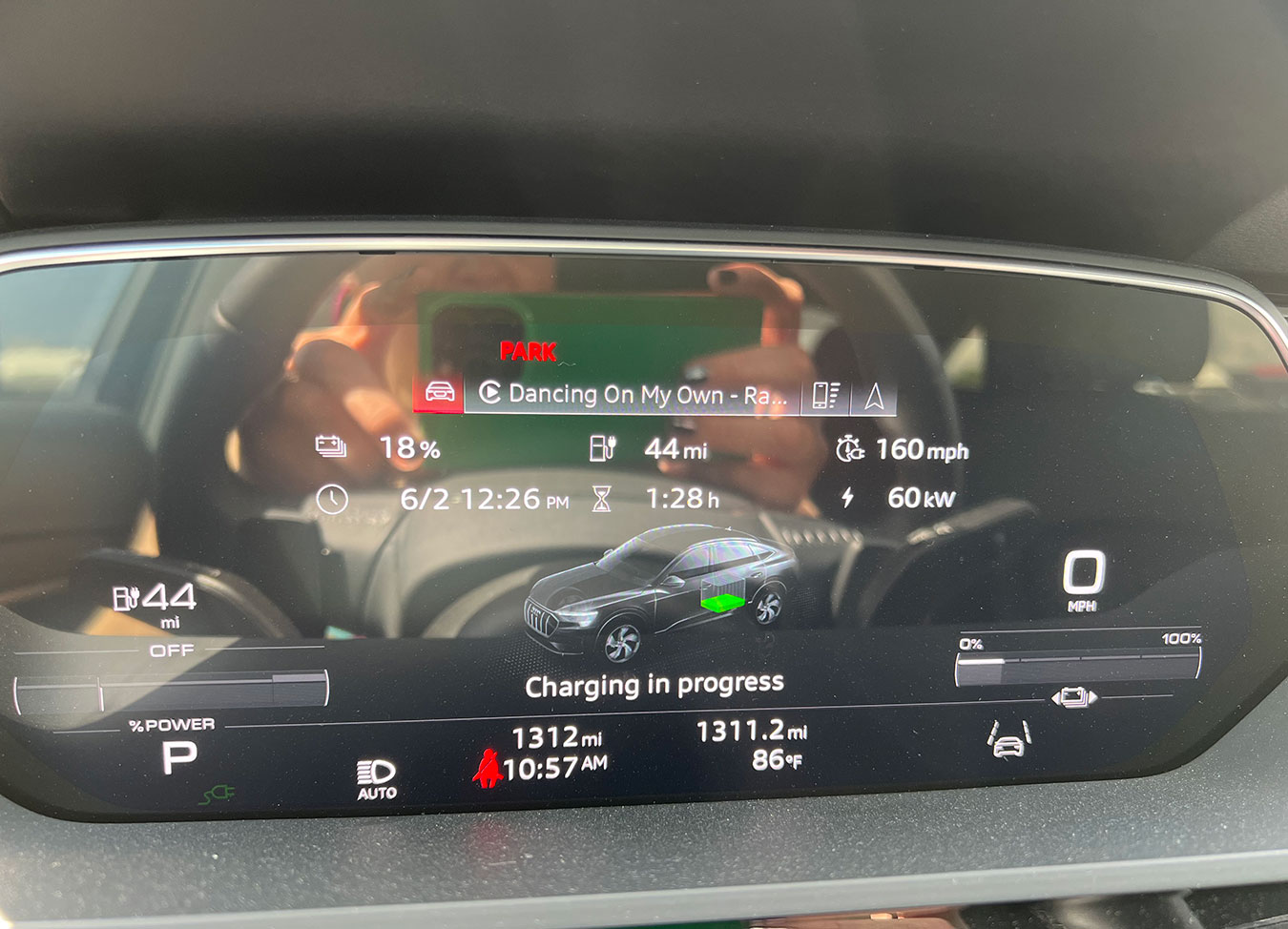
It’s time to talk about EV charging. There’s so much to know and I’ll try to make it easy to understand—and interesting. I’m also breaking this topic into two pieces: cables and plugs. Why? There’s a lot to know about both aspects of charging an EV.
One of the first charging insights I learned (and found surprising) is that most vehicle manufacturers recommend that you set your charging target to 80% versus 100%.
There are two reasons for this: charging performance and battery longevity. Most of the time you should only charge an EV to 80% because charging rates slow down dramatically once you get past the 80% mark. Also, the long-term health of your vehicle’s battery pack improves when you keep it below 100%.
An example of charging
In most EVs, you get to control the charging target. For my vehicle, I can control (set/change) the charging target from a mobile app and on the car’s central console.
Here’s an example of what that looks like using my vehicle’s mobile app. Note: In this case, I needed to take a longer drive, so I purposely wanted to charge my vehicle to 100%. But, for this exercise, let’s target a charge capacity of 80%.
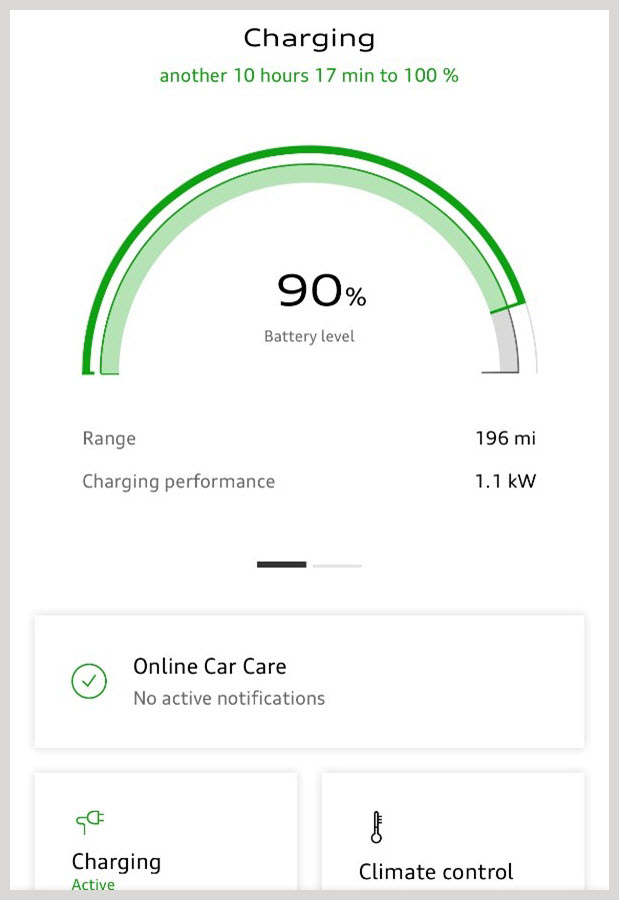
When I click on the graphic for the battery level, I can update the target charge:
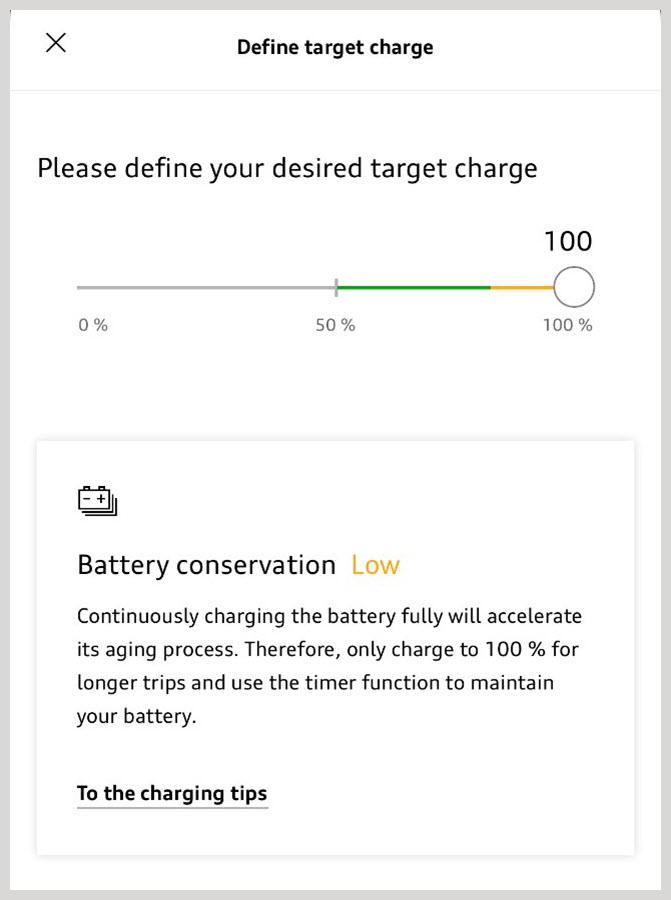
You can see that fully charging the battery ages the battery faster, but sometimes when you’re planning on a longer trip, you’ll need to get to 100%. I was curious what the app would say if I selected 90%. I got the same message as 100%: not advised as standard practice.
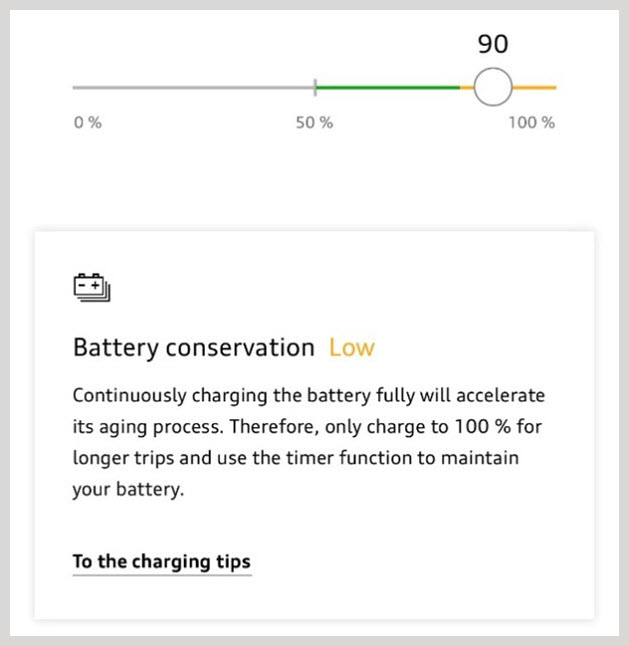
Here’s what the app says when you select the optimal charging target of 80%:
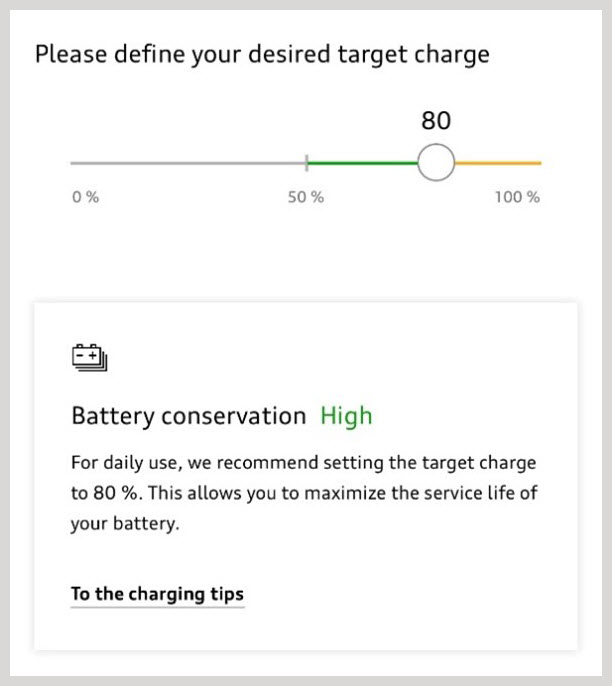
At the bottom, you’ll notice a link for “charging tips.” Since I’m writing a blog on EV charging, I decided to click on the link and here are the tips I received.
5 tips for charging
Tip #1
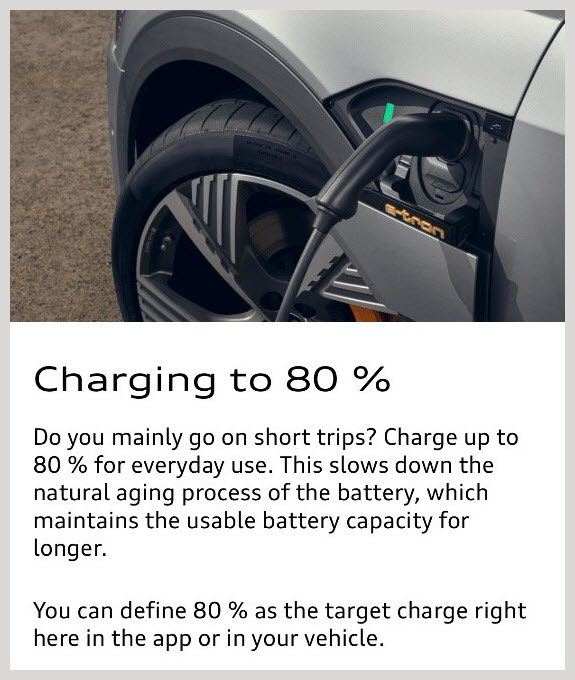
This is obviously important, because we’re focused on this topic.
Tip #2
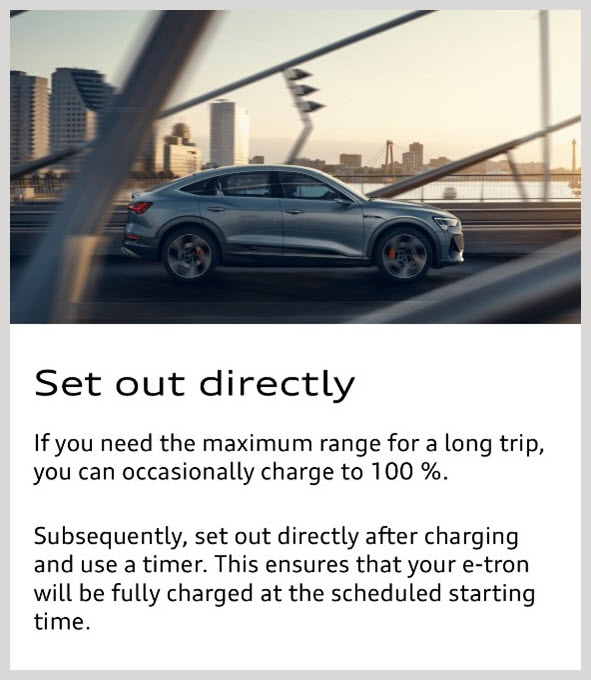
I already told you this, so here’s where I’m patting myself on the back for giving you factual, helpful information.
Tip #3
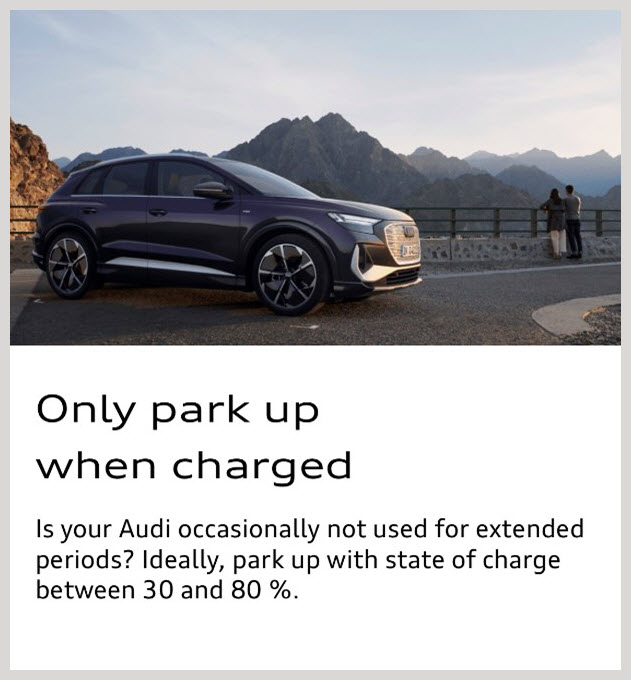
Going back to the first blog post in this series, I don’t know much about cars. I didn’t know the act of leaving your car unused for an extended period of time is called “parking up.” Duly noted.
Tip #4
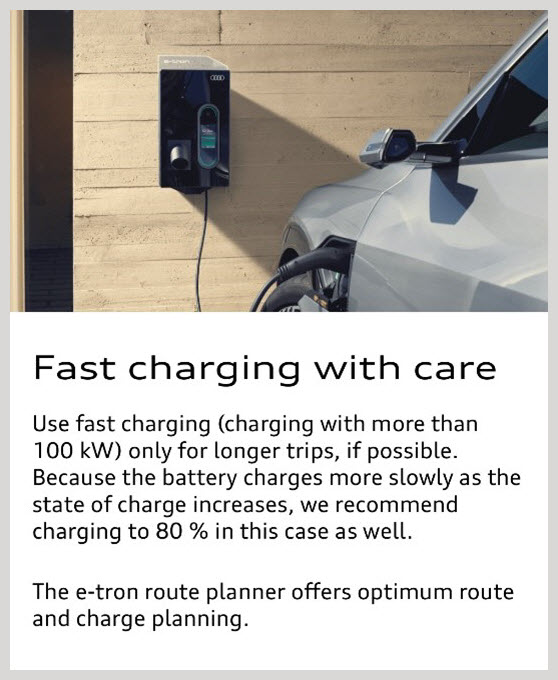
Soooooooo…you should minimize how much you use the best fast-chargers (at least at this point in time, using the most current technology). Fine. I will, but I’m not happy about it. I guess I’ll have more time to speak with Mrs. Christy. (You’ll learn who she is later in this post.)
Tip #5
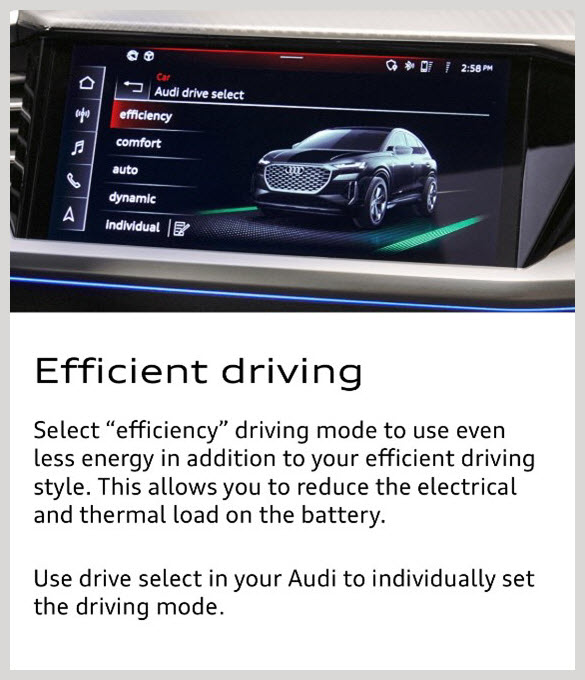
This is a pretty cool function of my vehicle. Depending on what I’m doing, I can adjust the car to a specific style of energy consumption and ride. The current mode is “efficiency,” because I said I’m going on a longer drive. My preferred mode is “comfort.”
The primary reason this is cool is because, when you select a different mode, you can feel the chassis lift or lower and it’s like you get a mini roller coaster ride (a nice little touch for thrill-seekers). Also please note that I’m in the stage of writing about vehicles where I just used the term “chassis” and actually knew what I meant.
Picking up with where we were before the mobile app distracted me: I was lowering the target charge from 100% to 80%. My car’s charge was already at 90%. When I saved the changes, this is what I saw on the screen:
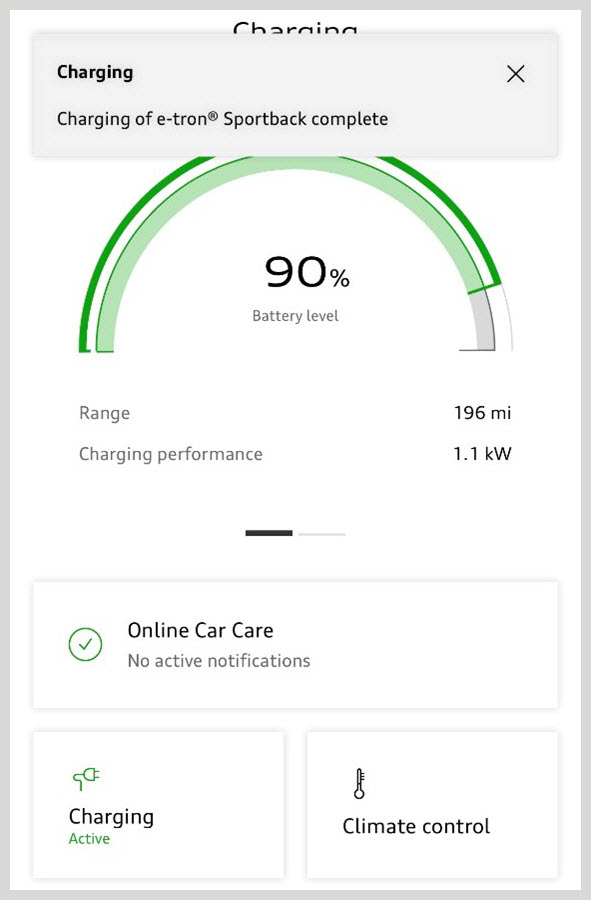
Because I lowered the target and the current charge is higher than the target, the vehicle stopped charging.
Source for all app screenshots: myAudi mobile app
Charging cable types
You know how your phone has a charging cable? Your EV will also have a charging cable. These cables are designed to safely deliver power from a power source to your EV.
There are four types of charging cables: Mode 1, Mode 2, Mode 3, and Mode 4.
| Cable Type | Technical Description | Bethany Translation |
| Mode 1 | This mode connects a light electric vehicle (e-bike, scooter) to a standard AC power outlet. It’s not considered safe for EVs and not legal for EVs in many parts of the world. | Basic phone charger model. |
| Mode 2 | This is the cable your EV will likely come with. It allows you to plug into a standard 3-pin outlet and charge without a charging station. The cable plugs into your EV charge port on one end and connects to a standard 3-pin domestic US socket on the other. Some advanced Mode 2 cables offer connectors suitable for different CEE socket types. Mode 2 charging cables come with an In-Cable Control and Protection Device (IC-CPD), which is responsible for the control of the charging process and communication between the electrical power source and the EV. | You can plug your car into a regular outlet. It’s easy and convenient, but it takes forever and the safety is questionable. |
| Mode 3 | These cables are the most common way to charge an EV, so they work globally. When you use a dedicated EV charging station (shopping centers, at home, in work parking lots), you’re most likely using this cable type. | This is what you’ll get at a standard EV charging station. |
| Mode 4 | These charging cables can handle the higher power outputs needed for fast-charging, which reduces EV charging from hours to minutes. Fast-charging means much more power is being fed to the battery at a faster speed, so these cables tend to be heavier and can handle the additional heat load generated by the higher power output. This type of cable is designed to transfer DC straight to the battery. This means you get more power faster and there’s no time required for conversion from AC to DC (one reason why it’s so much faster). | This is the good stuff: a fast-charging cable. A quick aside: It’s so confusing that another name for a Mode 4 cable is Level 3 (or DC charging). Who named that? |
If you’re trying to understand the differences between AC and DC charging, here’s a great resource.
How long does it actually take to charge?
In researching this blog post, I ran across a few articles that describe how charging (or refueling) your EV vehicle is the biggest difference in driving versus an Internal Combustion Engine (ICE). I don’t agree with this. Yes, the refueling motion is done through technically different devices, but if I’m using a super-charger or fast-charger, it feels similar to when I fuel up my tank at a regular “gas station.”
You may push back and think, “There’s no way it takes you about the same amount of time, so it can’t really feel the same.” I realize that everyone’s relationship with their preferred C-store/fueling station is different. Here’s a glimpse into my C-store choice and why the additional time spent fueling my EV doesn’t feel much different to me.
| Action | ICE | EV |
| Initiate payment process at the pump | 1 minute | 1 minute |
| Go inside and purchase a large unsweetened tea with lots of ice and say hello to Mrs. Christy, my kid’s pre-school teacher who now manages our local C-store | 10 minutes | 10 minutes |
| Mail packages or buy stamps at the post office in my local C-store | 5 minutes | 5 minutes |
| Total time spent in C-store | 16 minutes | 16 minutes |
| Time needed to refuel vehicle | 6 minutes | 40 minutes |
| How quickly I could have refueled | 7 minutes | 41 minutes |
| Realized investment of time | Minimum dwell time: 7 minutes Actual dwell time: 16 minutes I would have lost 9 minutes anyway, but with an ICE, I can elect to refuel faster. | Minimum dwell time: 41 minutes Actual dwell time: 16 minutes I would have 25 additional minutes of dwell time. |
My own charging preferences
Here’s a receipt for time verification showing it typically takes me between 30 to 40 minutes to return to a target charge of 80% (188 miles of charge) from an average starting point of 40 miles of charge.
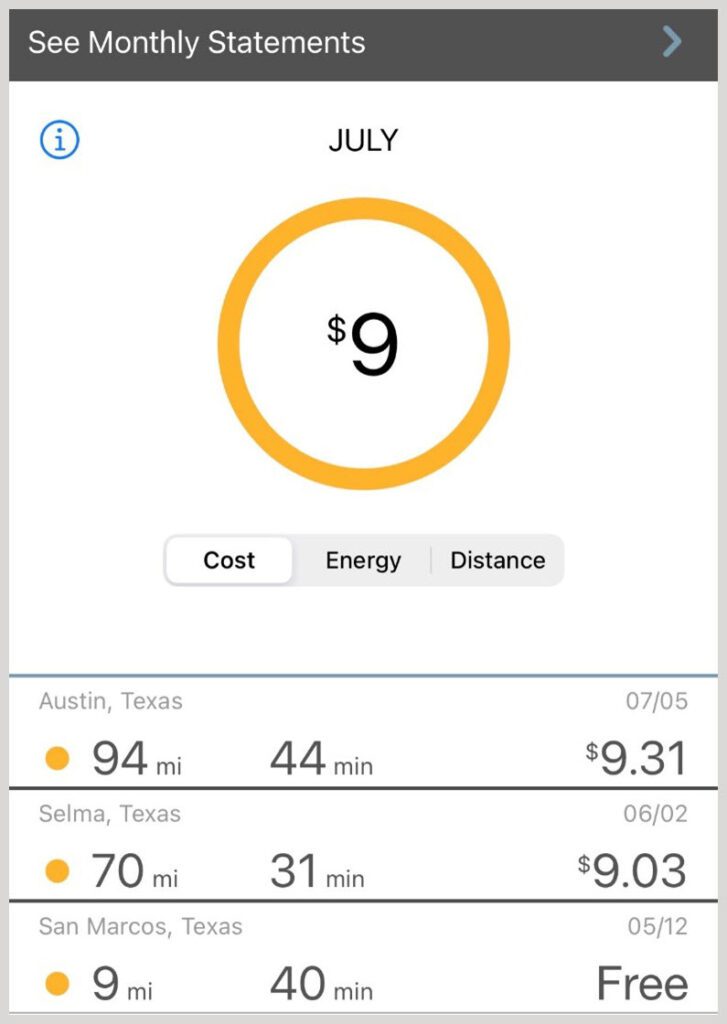
I guess the point I want to make is that, at current fast-charging speeds, it does take longer to refuel your EV—but not as long as you might think. When you integrate the motion of going into your C-store to perform some other tasks, the difference is minimized.
Rapid charging advancements coming soon
If you start thinking about the rapid advancements we’re expecting for charging speeds in the near- to mid-term future, refueling times for ICE vehicles and EVs will only become closer.
This is further supported by the fact that large convenience store chains like 7-Eleven and Buc-ee’s have already launched their own EV fast-charging networks. They realize how valuable convenience is to the consumer experience, so they’re making it as easy as possible to charge up on their premises.
I personally would much rather hang out in a convenience store than behind the local car dealership, which has the closest fast-charger where I live. The C-store gives me something else to do and it feels a lot safer than sitting alone behind a building.
If you’ve read this far, you might have noticed that I never mentioned how my chicken coop factors into charging my EV. I don’t want you to think this is some kind of bait-and-switch used car sales technique, so this is my pledge to write a bonus(!) blog post to explain more.
In case you missed the previous posts in this series, you can check them out here:
- I’m Not an EV Expert, But I Play One on TV
- Before You Buy an EV: The Research I Should Have Done
- Learning about Your New EV While Trying Not to Feel Stupid
- What I Learned from Having to Charge My EV on My Chicken Coop
E-mobily yours,
Bethany
EV and Convenience
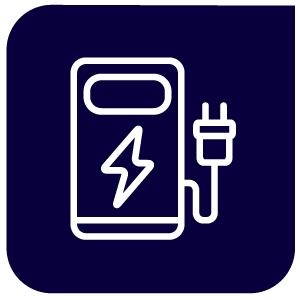
Learn more about EV and convenience with new resources in the EV Hub.


